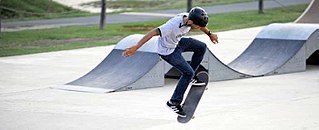
A skateboarding trick, or simply a trick, is a maneuver performed by manipulating a skateboard, usually with one's feet, in a specific way to achieve the desired outcome – the trick.

The kickflip is a skateboarding trick, in which the rider flips their skateboard 360° along the axis that extends from the nose to the tail of the deck. When the rider is regular footed the board spins counter-clockwise if viewed from the side.

An Indy grab, also known as an Indy air, is an aerial skateboarding, snowboarding and kitesurfing trick during which the rider grabs their back hand on the middle of their board, between their feet, on the side of the board where their toes are pointing, while turning backside. This trick is done only backside; the same maneuver done while turning front side, is called a front side air. The Indy grab is a generic skateboarding trick that has been performed since the late 1970s. This trick is performed mainly while vert skating, e.g. on halfpipes. Although this move can be done on flat land, it is much easier on a ramp. The Indy grab is one of the basic tricks in vert skating and is usually combined with spins, kickflips and heelflips.

John Rodney Mullen is an American professional skateboarder who practices freestyle skateboarding and street skateboarding. He is considered one of the most influential skaters in the history of the sport. Mullen is credited for inventing numerous tricks, including the flatground ollie, kickflip, heelflip, impossible, and 360-flip. As a result, he has been called the "Godfather of modern freestyle skating."
The Caballerial was originally a skateboarding trick performed in a half pipe, but has now been adopted in styles other than vert, and is also performed in BMX. The original trick is a fakie backside 360 ollie, or in BMX, a fakie 360. The Caballerial can also be done frontside The Caballerial was named after professional skateboarder Steve Caballero, who invented the trick in 1981, originally doing the trick backside.

The ollie is a skateboarding trick where the rider and board leap into the air without the use of the rider's hands. It is the combination of stomping, also known as popping, the tail of the skateboard off the ground to get the board mostly vertical, jumping, and sliding the front foot forward to level out the skateboard at the peak of the jump.

A bertslide, Bertlemann slide, or bert, is a skateboarding trick where the skateboarder puts one hand on the ground and rotates the board while it is still on the ground, effectively sliding on the wheels of the skateboard. The trick was named after the surfer Larry Bertlemann, who first performed the trick on a surfboard, then later incorporated it into his skateboarding. The original version of the trick was a 180-degree turn. The Z-Boys, an influential group of mid-1970s skateboarders, adapted the move by extending the slide to 360 or even 540 degrees.
In surfing, skateboarding, snowboarding and aggressive inline skating, frontside and backside are terms that are used to describe how a person approaches an obstacle or performs a certain trick. In aggressive inline skating, frontside and backside are types of grinds.
Casper is a freestyle skateboarding trick that was invented by Bobby "Casper" Boyden in the late 1970s. Boyden had a very pale skin and he was nicknamed after the cartoon ghost. The modern casper was invented by Rodney Mullen in the late 1980s.
A freestyle skateboarding trick is a trick performed with a skateboard while freestyle skateboarding. Some of these tricks are done in a stationary position, unlike many other skateboarding tricks. The keys to a good freestyle contest run are variety, difficulty, fluidity, and creativity. This is an incomplete list, which includes most notable tricks.
A flip trick is a type of skateboarding trick in which the skateboard rotates around its vertical axis, or its vertical axis and its horizontal axis simultaneously. The first flip trick, called a kickflip but originally known as a "magic flip", was invented by professional skateboarder Rodney Mullen.

In skateboarding, grinds are tricks that involve the skateboarder sliding along a surface, making contact with the trucks of the skateboard. Grinds can be performed on any object narrow enough to fit between wheels and are performed on curbs, rails, the coping of a skate ramp, funboxes, ledges, and a variety of other surfaces.

A slide is a skateboarding trick where the skateboarder slides sideways either on the deck or the trucks.
The no comply is a skateboarding trick that was invented by John Lucero and then named and popularized by the skater Neil Blender in the 1980s.

In skateboarding, a nollie, short for "nose ollie", is an ollie executed at the front of the board while the rider is positioned in their natural stance. Professional skateboarders Karl Watson, Shuriken Shannon, Tuukka Korhonen, and Sean Malto have been recognized for their ability to perform the nollie trick. A nollie can be easily confused with a fakie ollie, whereby the rider uses their original foot position but is instead riding backwards.

Wallenberg, also known as the Wallenberg Four, is located at the Raoul Wallenberg Traditional High School in San Francisco, California, United States.

A caster board, vigorboard or waveboard is a two-wheeled, human-powered land vehicle. Other names are J-board and RipStik, both of which are derived from commercial brands.
The nightmare flip, is an aerial skateboarding trick.
















